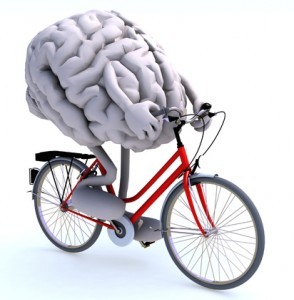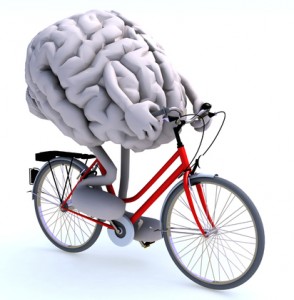The endlessly fascinating topic of how cycling affects the brain
 If you’re a regular reader of this blog you’ll know that I have a fascination for brain science, so was intrigued to read an article recently about how cycling affects the brain. I’m not sure what fascinates me so much but I always enjoy reading about the connection between the brain and cycling. I found the article on a site called Duvine which runs cycling tours so I asked permission to republish the article written by Lindsey Hunt.
If you’re a regular reader of this blog you’ll know that I have a fascination for brain science, so was intrigued to read an article recently about how cycling affects the brain. I’m not sure what fascinates me so much but I always enjoy reading about the connection between the brain and cycling. I found the article on a site called Duvine which runs cycling tours so I asked permission to republish the article written by Lindsey Hunt.
How does bike riding impact our mental and emotional health on a scientific level?
The Evolutionary Basis
Anthropologists and psychologists suggest that the evolutionary roots for the cyclist’s brain go back over two million years. When humans transitioned away from a relatively sedentary ape-like lifestyle, our hunter-gatherer ancestors began to engage in mentally complex and physically demanding tasks such as foraging for food and chasing prey. Over time, our biology adapted to respond to these increased activity levels, rewarding us for engaging in tasks that combine mental engagement with aerobic exercise.
When we fast forward to the desk-bound modern lifestyle, the motivation to ride is an evolutionary leftover of our primitive instinct to explore and seek sustenance. Engaging in regular aerobic exercise such as cycling leads to a fall in levels of a “fat” hormone called leptin. Leptin indicates to our brain that the body has enough energy. When leptin levels are low, we experience an extra boost of motivation for physical activity as a means to “pursue food.” When we follow this urge and head out for a rigorous ride, our bodies are flooded with a pleasurable cocktail of norepinephrine, dopamine, endorphins, anandamide, and serotonin that allow us to keep riding longer and harder. This creates a self-perpetuating cycling of drive and reward that keeps cyclists coming back for more.
Cycling as Neural Fertiliser
Cycling doesn’t just make us feel good; it actually builds a bigger, more connected brain. As we pedal, we increase healthy blood flow to the entire body, including the brain. Pumping oxygen and nutrients into this metabolically rapacious organ provides a kind of neural fertilizer, creating rich capillary beds in our brain’s gray matter and increasing the brain’s capacity to grow, function, and repair itself. Cycling fires up extra nerve cells, intensifying the creation of a protein called BDNF that stimulates the formation of new brain cells. Through this process, cycling can double or even triple the production of neurons. As a result, cycling helps stimulate regions of the brain such as the hippocampus, which plays a critical role in memory formation and spatial navigation.
In addition to increasing grey matter, cycling has been shown to boost the brain’s white matter. White matter is like the brain’s subway system—it transmits information between different parts of the body and the cerebral cortex. Engaging our motor skills in activities like cycling helps keep this system running smoothly. The latest evidence comes from a study conducted in the Netherlands in which half of the participants were randomly assigned to a six-month exercise program on stationary bikes. Even though subjects may have biked in daily life, the extra practice made a difference. Brain scans of subjects assigned to the cycling program showed a significant increase in the strength of white matter fibre tracts in both healthy and schizophrenic patients.
Faster, Stronger, Happier
Given the neurological benefits of cycling, it’s no wonder that cycling leads to better cognitive function. One study of young, healthy men looked at their scores on cognitive tests before and after pedaling a stationary bike at moderate intensity for 30 minutes. After cycling, the participants completed the tests faster than before and scored higher on memory, reasoning, and planning. Riding a bike also appears to be helpful in treating ADHD. Some people have gone as far as to call cycling a “natural Ritalin.” Scientific evidence behind these observations is increasing, with one study finding that after aerobic exercise, the brains of ADHD-diagnosed children exhibit comparable neural function to the brains of children who don’t have ADHD.
The mental benefits of cycling extend to our emotional health as well. Cycling floods our bodies with powerful neurotransmitters—the very same chemical compounds targeted by anti-anxiety and anti-depression medications. As we ride, levels of serotonin (the “happy hormone”) rise and remain elevated throughout the day, sustaining that post-ride afterglow that cyclists seek. We experience a spike in dopamine, which makes us feel good, hones our focus, and speeds up muscle reaction times. Our body pumps out norepinephrine, allowing us to process information on a subconscious level and giving us that blissful feeling of suspended time.
Interestingly, cycling also increases blood levels of a natural cannabinoid called anandamide. Cannabinoids affect the same part of the brain acted upon by marijuana, which explains why so many people feel a “cyclist’s high” during a long ride. The activation of the endocannabinoid system gives cyclists a boost of euphoria, enhances creative thinking, and helps us find novel solutions to problems.
The mental and emotional benefits of cycling have a profound impact on our wellbeing. Engaging in regular aerobic exercise like cycling prevents and alleviates stress, anxiety, and depression. One study looked at the levels of cortisol, a stress hormone, in depressed participants before and after pedaling a stationary bike. After just 15 minutes of pedaling, cortisol levels declined and subjective reports of depressive symptoms improved. Another study analyzing 26 years of research found that as little as 20 to 30 minutes a day of aerobic exercise can prevent depression over the long term.
Hitting the Sweet Spot
Now that we’ve explored some of the neurological benefits of cycling, here are three tips for putting cycling to work towards improved mental welfare:
1. Keep It Moderate
Research suggests that 30-60 minutes of steady riding at a sustained pace is ideal to reap the neurological benefits of biking. Likewise, the feel-good flood of endorphins and neurotransmitters peaks when we exercise at 60-80% of our maximum heart rate. Neither all-out sprinting nor a leisurely spin around the block will produce the cyclist “high.” Think of it as riding at a 7 out of 10. Interestingly, many group rides naturally default to this pacing.
2. Find your Flow
The cocktail of neurotransmitters that make us feel relaxed, focused, and creative during a ride peaks when we’re in a state of flow.
Flow happens when we challenge ourselves relative to our skill level. This means that there is no one-size-fits-all kind of ride. Flow might look like pedaling on a bike path for a novice, or zooming down a thrilling descent for an experienced rider. The key is to feel challenged without feeling overwhelmed.
When we hit this sweet spot, our nervous systems are presented with slightly more information than we can process on a conscious level. There’s no time to “think.” The prefrontal cortex shuts down and subconscious processing takes over. Distractions, busy thoughts, and worries melt away as we become completely absorbed in what we’re doing.
In contrast, when we’re too challenged, our bodies overproduce adrenaline. This creates anxiety and fills our receptors so that the body can’t absorb other neurochemicals like dopamine and anandamide. Be kind to yourself (and your brain!) by choosing a ride that fits your ability level.
3. Go Green + Explore
Spin class devotees may want to consider that, compared to indoor exercise, exercising outdoors is associated with greater feelings of revitalization, energy, and positive engagement—plus decreased feelings of tension, anger, and depression. Simply spending time in nature reduces stress and decreases symptoms of anxiety and depression.
There’s evidence that “green exercise” more specifically can boost enjoyment and motivation. The most creative study of this effect on cyclists was, ironically, conducted indoors. Participants pedaled a stationary bike while watching a five-minute video of a leafy green cycling trail that was altered to appear in three forms: unedited (green), grey, and red. After viewing the unedited green version, volunteers reported a less negative mood and a greater sense of ease, even though their heart rate and breathing was the same across conditions.
Last but not least, get off the beaten track and mix up your cycling routes. Join a group ride in your area, explore a new route on Strava, or explore by bike on your next vacation. Exercising in a novel environment provides a stimulating mental challenge that may have extra benefits for your brain.


Great article. The brain fascinates me as well. Thanks for sharing!